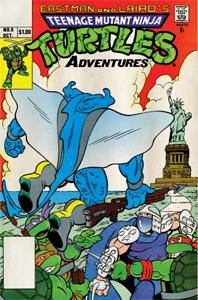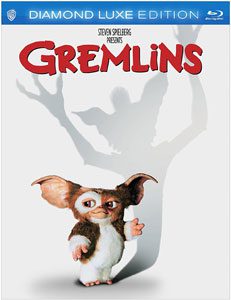The early issues of Archie Comics’ “Teenage Mutant Ninja Turtles Adventures” (which would eventually run from 1988-96, paralleling the cartoon’s run) adapt the first seven episodes of the cartoon (in a three-issue miniseries and Issues 1-4 of the main title). According to “TMNT: The Ultimate Visual History” (2014), these issues sold well but Mirage Studios had trouble meeting its deadlines with Archie due to not having a full-time team running “Adventures.”
Wanting to break free from cartoon adaptations anyway, Eastman & Laird allowed Mirage staffers Ryan Brown and Stephen Murphy (who uses the pen name Dean Clarrain when writing children’s stories) to graft their vision onto the cartoon’s origin story. They take over with Issue 5 in October 1989, and thus the third major branch of “TMNT” continuity begins.
Leatherhead, terror of the multiverse
This didn’t come with a major announcement. As a kid, I might’ve assumed the differing origin stories for various mutants were “mistakes.” Maybe I subconsciously grasped the idea of multiverses, even though I was ignorant of Marvel’s classic “Crisis on Infinite Earths” from earlier in the 1980s.

“Teenage Mutant Ninja Turtles Adventures” Issues 5-11 (1989-90)
Archie Comics
Issues: “Something Fishy Goes Down” (5), “Of Turtles and Stones and Mary Bones” (6), “Intergalactic Wrestling” (7), “Wild Things” (8), “Codename: Chameleon” (9), “Going Down?” (10), “White Light” (11)
Writers: Stephen Murphy (as Dean Clarrain) (all), Ryan Brown (5, 6, 7)
Pencils: Ken Mitchroney (5, 6, 8, 10), Jim Lawson (7, 9, 11)
Inks: Dave Garcia (5, 6, 7), Dan Berger (8, 10, 11), Gary Fields (9)
Colors: Barry Grossman (all)
A prime example is Leatherhead. He’s introduced in Mirage Comics’ “Tales of the TMNT” Issue 6 in 1988 as a troubled but decent soul, a sewer gator mutated by the same ooze that got the Turtles. In 1989 he got an action figure which dubbed him a bad gator, mutated in the Florida swamps.
In November 1989’s “Adventures” Issue 6 (“Of Turtles and Stones and Mary Bones”) he’s the human thief Jess Harley, magically transformed into a gator; he’s neutral toward the Turtles, and nutso. The same month, Leatherhead debuted in the cartoon as a baddie similar to his action-figure card description, but with an upright stance rather than the figure’s low-to-the-ground pose.
If toys and comics are supposed to encourage imagination, the “TMNT” saga succeeded, because a kid has to have a flexible brain to absorb the different Leatherheads – otherwise he’d go as crazy as, well, Leatherhead.
Archie, the cartoon and Playmates Toys show a sloppy kind of synergy during this period. There’s a lot of character crossover, but inconsistencies in characterization and design. In terms of sales, I’m sure it didn’t hurt them a lick.
Artificial edge
As I began my Archie re-read, I prepared for deeper plots and arcs than the cartoon’s. My memory proved inaccurate. My inflated remembrance of Issues 5-11 (October 1989-June 1990) comes because all of them introduce a fun new mutant, most of which were (or would become) action figures.
These stories are shockingly thin. Each issue could be a cartoon episode, except they’d be flat and short on humor. “Adventures” is nominally “edgier” than the cartoon – the Turtles roughhouse, trade light insults and have many negative expressions (scowls, annoyance, boredom) – but it is very much for young readers.
The plots are ultra-simple, and so short on thematic lessons that one issue even makes a joke about it. Splinter is perpetually bemused, content to be a sounding board for Leo rather than giving instructions. When the Turtles announce they’ve returned from outer space, Splinter barely bothers to look up from his TV news (which he loves in this incarnation).
With the Technodrome in Dimension X (as per the last story shared by the toon and Archie, “The Incredible Shrinking Turtles”), Shredder, Bebop and Rocksteady establish a sewer-accessible headquarters building and devise schemes. B&R are less comical than in the toon, but equally hapless.
Krang has a more focused goal, at least: to acquire Mary Bones’ Turnstone. Plus, the warlord brain’s viciousness is emphasized in Issue 8 (“Wild Things”) when we learn the tragic backstory of mayhem villains Wingnut & Screwloose (a symbiotic giant bat and mosquito in the 1990 toy line), the last of their species after Krang conquered their homeworld.
Venturing off-world
The tales are paper-thin, but the mutant designs remain cool. In Issue 5 (“Something Fishy Goes Down”), we meet Man-Ray (“Ray Fillet” as a 1990 action figure), invented by Brown based on Murphy’s personality, according to “The Ultimate Visual History.” This first original Archie issue establishes Murphy’s pet theme of environmentalism (which, admittedly, fits well with an anthropomorphic saga), as aquarium worker Jack Finney gets mutated while investigating pollutants piped into the ocean by reckless city infrastructure.
“Adventures” soon makes its world bigger than the cartoon’s. There’s a sense of scope when the Turtles encounter a cool underground bridge in Issue 6 – site of their confrontation with Leatherhead – and more so when they go to outer space for Issue 7 (“Intergalactic Wrestling”). They’re slurped up by a giant cow’s head, Cudley the Cowlick, who spits them out at the sports venue floating in the void. I find this spittle-heavy mode of transportation gross, although I like Cudley’s friendliness toward the Turtles.
“Intergalactic Wrestling” – a briefer adventure than I recalled, because I mix it up with the first intergalactic arc in early Mirage — gives us a peek at Ace Duck, a 1989 action figure who neither the comic nor the cartoon embraced as a main character (his cameo in the latter is even briefer). Here, he’s a preening wrestler defeated by an irked Leatherhead. (He’s less annoying than Cryin’ Houn’, though.)
Issue 7 gives us Clarrain’s next environmental mini-lecture, as Cudley briefly drops the Turtles in 2089 New York, which looks like a rundown Venice, with canals for streets. Calling to mind the “Valerian and Laureline” vision of a dystopian future 1986, these panels are an early peek at the Dark “TMNT” Future that both Mirage (in shorts) and Archie hinted at.
Issue 9 (“Codename: Chameleon”) is one of those missed action-figure opportunities that was frustrating as a kid. Shredder, out of sheer villainy, mutates a stealthy thief into a literal chameleon rather than maturely paying a fair price for a secret weapon design. Maybe Playmates felt it couldn’t do justice to a character who can blend into his surroundings.
Roaches and rats
Issue 10 (“Going Down?”) introduces Scumbug (an action figure in 1989) and Wyrm (1990), but then (seemingly) kills them off, as if Murphy isn’t invested. Scumbug is an exterminator-turned-roach, which could lead to good character development. Wyrm is simply a mutated flatworm. He’s the closest (and it’s not particularly close) we would get to Mirage’s Bloodsucker (owned outside of Mirage by Rick Veitch) jumping to the wider Turtle-verse.
As a youth, I loved Issue 11 (“White Light”) because it features the Rat King – invented in Mirage’s “Tales of the TMNT” Issue 4 in 1988. Calling himself Ha’ntaan and displaying slight mental illness, he exchanges threats and insults with the Turtles but lets them pass through his sewer territory. He gives no backstory, but I’m intrigued.
Clarrain uses a throw-it-at-the-wall process of invention in Issue 11, as the randomly introduced Sons of Silence (gray alien ghosts) are suddenly allied with Krang and Shredder. The aliens abduct the Turtles and bring them to the Technodrome, which – in another random twist – morphs into a spaceship.
As much as these on-the-fly inventions call to mind the cartoon, I also sense that Clarrain introduces these elements (along with Mary Bones morphing into her “true” form in the final panels) as a springboard to grander adventures with more complex plots, themes and lessons.
On their own, though, Issues 5-11 are defined by action figure cross-promoting. As far as toy advertising goes, it’s good stuff. As far as reading goes, it’s very much kid stuff.


